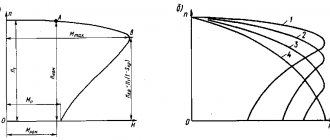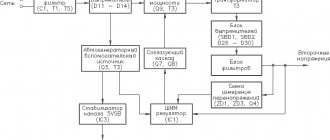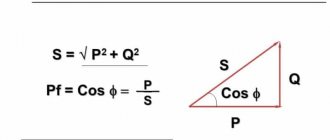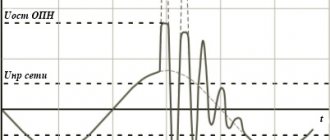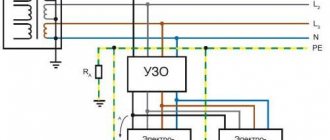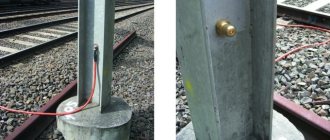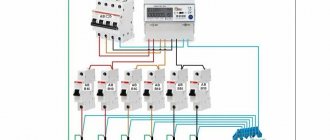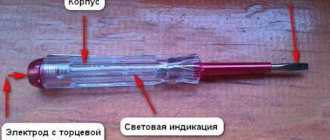Page 2 of 56
Chapter I GENERAL INFORMATION ABOUT ELECTRICAL INSTALLATIONS § 1. Basic concepts and definitions
Electrical installations are installations in which electricity is produced, converted, distributed and consumed. Electrical installations are divided by purpose, type of current and voltage. According to their purpose, as can be seen from the definition itself, electrical installations are divided into generating (producing electricity), consumer (consuming electricity) and conversion-distribution (for transmitting, converting electricity into a form convenient for consumers and distributing it between them). Depending on the type of current, electrical installations are divided into direct and alternating current. Based on voltage, electrical installations with voltages up to 1000 V and above 1000 V are distinguished. Electrical installations with voltages up to 1000 V are usually divided into power and lighting. Electricity is generated by electric generators installed at power stations. Depending on the type of energy from which electricity is generated, power plants are divided into two groups: thermal power plants (CHP) and hydroelectric power plants (HPP). Powerful district thermal power plants (GRES) produce predominantly electrical energy. They are equipped with powerful units with condensing steam turbines, the exhaust steam in which enters special devices “condensers”, where it is cooled and condensed. Therefore, such thermal power plants are also called condensing power plants (CPS). In places where, in addition to electricity, a large amount of thermal energy is required (industrial centers, individual large enterprises), combined heat and power plants (CHPs) are built. They are equipped with units with heating turbines, which make it possible to extract part of the steam to provide consumers with thermal energy. Thermal power plants can operate on coal, fuel oil and gas. A separate group includes nuclear power plants (NPPs) that use nuclear fuel. Consumer electrical installations are a variety of electricity receivers installed at electricity consumers. At the same time, consumers of electricity are all sectors of the national economy (industry, transport, agriculture, etc.). as well as cultural buildings, hospitals, scientific institutions and educational institutions. Electricity receivers are varied. These include: electric motors that drive a variety of machine tools and electric vehicles; electrical technological equipment (welding machines and devices, electric furnaces, electrolyzers, machines for electric spark processing of metals, etc.); electrical household appliances (electric stoves, floor polishers, vacuum cleaners, washing machines, radios, televisions, etc.); electromedical devices and devices (X-ray machines, devices for electrotherapy and electrodiagnostics, etc.); instruments and installations for scientific institutions (electron microscopes and oscilloscopes, radio telescopes, synchrophasotrons) and, finally, a wide variety of electrical light sources. For the transmission and distribution of electricity, electrical networks are used, connecting power stations with each other and with electricity consumers. Electrical networks include power lines, distribution networks and electrical wiring. Power transmission lines connect power plants with each other and with power supply centers for electricity consumers. In distribution networks, electricity is distributed between individual consumers and converted. Therefore, distribution networks are characterized by great branching and include many electrical substations and distribution devices. At electrical substations, electrical energy is converted by voltage (increasing or decreasing voltage) or by type of current (converting alternating current to direct current and vice versa). Distribution devices (RU) serve to distribute the electricity passing through them between individual consumers and always contain busbars, to which power is supplied with many branches to power individual consumers. Electrical wiring is usually used to distribute electricity between individual electrical receivers in installations with voltages up to 1000 V. Unlike other types of products, electrical energy is distinguished by the unity and continuity of the processes of its production, transportation (transmission) and consumption. This difference in electricity also determines the fundamental differences between enterprises producing and selling electricity, as well as thermal energy (since the generation of thermal energy at thermal power plants is carried out mainly by the same equipment and at the same time as electricity).
Rice. 1. Schematic representation of a section of the electrical system: 1 - hydroelectric power station. 2 - hydrogenerator, 3 - power transformer. 4 - switch, 5 - switch drive, 6 - current transformer, 7 - power line, 8 - city, 9 - hydroelectric power station control panel, ; 0 - control key, 11 - automation relay, - 12 - protection relay, 13 - ammeter, 14 and 15 - telemechanics devices, 16 - control panel
The main industrial enterprise in the electric power industry is an energy system (energy system), which is a set of power plants, electrical and thermal networks and electricity consumers, interconnected into one whole by the commonality of the regime and the continuity of the process of production and distribution of electrical and thermal energy. The electrical part of the power system is called the electrical system. Any electrical installation must be controllable and, therefore, must have, in addition to elements performing energy functions (production, transmission, conversion and consumption of electricity), elements performing information functions (control, protection, measurement). In Fig. Figure 1 schematically shows a section of the electrical system, which depicts the main elements necessary for the production, conversion and transmission of electricity. Electricity generated at hydroelectric power station 1 via power line 7 is transmitted to city 8. Primary equipment is used for energy transformations: hydrogenerator 2, which converts mechanical energy into electrical energy, power transformer 5, which converts electrical energy into electrical energy of a higher voltage, which is necessary for its transmission with minimal losses along the power line 7, and the high-voltage switch 4. To monitor the condition of the primary equipment and control it, secondary devices and instruments are used: the drive of the high-voltage switch 5, connected to it kinematically and controlled from the control panel remotely by acting on the control key 10 or automatically from the protection relay 12 and automation 11, a measuring device (ammeter) 13 connected to the secondary winding of the current transformer 6, the primary winding of which is connected to the primary circuit; a telemechanics device, one half-set 14 of which is installed on the control panel 9 of the hydroelectric power station, and the other half-set 15 on the control panel 16. All secondary instruments and devices are designed for information transformations, they are included mainly in secondary circuits, at the beginning of which there is a primary converter (in the figure, a transformer current 6), directly connected to the primary circuit and receiving the necessary information from it, and at the end - a direct control element (in the figure, drive 5 of the high-voltage switch), through which a direct influence is exerted on the controlled primary circuit. Since instrument transformers and drives of primary devices are geographically located in switchgears, their description is given in the section on switchgears.
§ 2. Voltages of electrical installations
To ensure normal operating conditions for electrical receivers, their interchangeability, as well as coordination of the voltage level of all parts of the electrical system, from generators of power stations to electrical receivers, the voltage for which electrical equipment is manufactured is legalized by the State Standard (GOST 721-62), according to which The following nominal voltages are set; at the terminals of DC generators -115, 230 and 460 V; at the terminals of alternating current generators with a frequency of 50 Hz between phase wires (line voltage) - 230, 400, 690, 3150, 6300, 10500, 21,000 V; at the terminals of three-phase current transformers with a frequency of 50 Hz between phase wires (line voltage) at the primary windings -0.220; 0.380; 0.660; 3 and 3.15; 6 and 6.3; 10 and 10.5; 20 and 21; 35; 110; 150; 220;330; 500; 750 V, for secondary windings - 0.230; 0.400; 0.690; 3.15 AND 3.3; 6.3 and ?.6; 10.5 and 11; 21 and 22; 38.5; 121; 165; 242; 347; 525; 787 kV (voltages 3.15; 6.3; 21 kV for the primary windings of transformers refer to step-up and step-down transformers connected directly to the generator voltage buses of power plants or to the terminals of generators); DC power receivers - 6, 12, 24, 36, 48, 60, 110, 220, 440 V; three-phase electricity receivers with a frequency of 50 Hz: between phase wires (line voltage)—36, 220, 380, 660, 3000, 6000, 10,000, 20,000, 35,000, i 10,000, 220,000, 150,000, 330,000, 500,000 and 7 50000 V; between phase and neutral wire—127, 220, 380 V; single-phase electrical energy receivers with a frequency of 50 Hz - 12, 24, 36, 127, 220, 380 V.
§ 3. Representation of electrical installations in the drawings
Types and types of schemes. To depict electrical installations in drawings, such well-known means as construction drawings with plans and sections are used; individual products are depicted according to standards and GOSTs for mechanical engineering. But these visual aids are not enough to understand the principle of operation and design, install and operate most electrical installations and products. Therefore, the main means for depicting electrical installations in drawings is a diagram. Diagrams are used to visually represent the elements of an electrical installation and the connections between them in drawings. Along with electrical elements that form electrical circuits, in some cases electrical installations include hydraulic, pneumatic and mechanical elements that form hydraulic, pneumatic and kinematic circuits, respectively. GOST 2701-68 provides for the following types of circuits: electrical, hydraulic, pneumatic and kinematic. Depending on their purpose, diagrams are divided into the following types: structural, functional, fundamental (complete), connections (installation), connections, general and location. Structural diagrams define the main functional parts of the product, their purpose and interconnection. These diagrams are developed during the design of products (installations) at stages preceding the development of schemes of other types, and they are used during operation for general familiarization with the product (installation). Functional diagrams explain certain processes occurring in certain functional circuits of a product (installation) or in the product as a whole. Functional diagrams are used to study the principles of operation of a product, as well as when setting it up. Structural and functional diagrams represent the product in the form of separate blocks, depicted by rectangles, which are arranged in a certain sequence and connected by arrows that define the connections between these blocks. Each block may consist of many elements that are not displayed on the indicated diagrams, but in general are intended for a specific conversion, for example: a rectifier, an amplifier, a DC-AC voltage converter (inverter), a frequency converter, etc. Functional diagrams are usually more detailed than structural diagrams. The block representation of these diagrams determines that in the literature they are often called block diagrams. A schematic (complete) diagram defines the complete composition of elements and connections between them, gives a detailed idea of the operating principle of the product (installation), serves as the basis for the development of other design documents and is used to study the principles of operation of the product, as well as during its adjustment. If the product (installation) includes devices that have circuit diagrams, then such devices in the product diagram should be considered as elements. In this case, the operating principle of the product is determined by the combination of its circuit diagram and the circuit diagrams of the specified devices. The connection diagram (installation diagram) shows the connections of the component parts of the product (installation) and defines the wires, harnesses, cables and pipelines that make these connections, as well as the places of their connection and input (clamps, connectors, bushings, etc.). They are used when making connections (installation), as well as when setting up the product. The wiring diagram (formerly called an external wiring diagram) shows the external connections of the product. The general diagram defines the components of the complex and their connections at the site of operation. The layout determines the relative location of the component parts of the product (installation), and, if necessary, also wires, harnesses, cables, etc. As stated earlier, when drawing up diagrams, the individual elements of the product and the connections between them should be clear. In this case, the following conventional graphic symbols are used, established by GOSTs: GOST 2.721-74. Designations for general use. GOST 2.722-68. Electric cars. GOST 2.723-68. Inductors, chokes, transformers and magnetic amplifiers. GOST 2.724-68. Electromagnets. GOST 2.725-68. Switching devices. GOST 2.726-68. Current collectors. GOST 2.727-68. Dischargers, fuses. GOST 2.728-68. Resistors, capacitors. GOST 2.729-68. Electrical measuring instruments. GOST 2.730-68. Semiconductor devices. GOST 2.731-68. Electrovacuum devices. GOST 2.732-68. Sources of light. GOST 2.738-68. Elements of telephone equipment. GOST 2.741-68. Acoustic devices. GOST 2.742-68. Electrical current sources. GOST 2.745-68. Electric heaters, electrothermal devices and installations. GOST 2.750-68. Type of current and voltage, types of winding connections, pulse shapes. GOST 2.751-68. Electrical communication lines, wires, cables, buses and their connections. The dimensions of conventional graphic images are established by GOST 2.747-68. The rules for the implementation of electrical, kinematic, as well as hydraulic and pneumatic circuits are defined by GOST 2.702-69, 2.703-68 and 2.704-68. Designations of electrical equipment and wiring on plans (if necessary and on sections) of buildings, territories and individual premises are established by GOST 7621-55.
Rice. 2. Symbols of power plants and substations: a - general, b - open installation, c - closed installation. d - mobile installation In Fig. 2 in the top row shows symbols of power plants and in the bottom - substations: general (Fig. 2, a), open installation (Fig. 2, b), closed installation (Fig. 2, c), mobile installation (Fig. 2, d) (designations of existing structures are shaded). In Fig. 3 shows the designations of electrical networks and structural elements for electrical wiring, and in Fig. 4 - designations of lamps and installation electrical appliances. Usually, next to the graphic designation, an explanatory inscription is given indicating the serial number of the corresponding equipment, its type, and sometimes some parameters. For example: P - starter, 2ShR - distribution cabinet, the designation of the lamp 3/60 says that it has three lamps of 60 W each, etc. In addition, the State Standard also establishes symbolic graphic designations of power plants and substations in power supply diagrams (GOST 2.748-68), designations of basic quantities and symbols of devices in production process automation diagrams (GOST 3925-59). GOST 9099-59 occupies a special place. A system for marking circuits in electrical installations (labeling issues are discussed below). All electrical installation diagrams can be divided into two groups! primary (power) and secondary switching (control, alarm, blocking, protection and automation circuits). Secondary switching circuits are usually more complex than the primary circuits to which they belong. Of all the diagrams, three are most common in electrical installations: fundamental (complete), connections (installation) and connections. Schematic diagrams of secondary switching are performed in separate circuits, with each circuit starting at one pole of the DC source (or at one of the phases of the AC source) and ending at the other pole of the DC source (or at the other phase, or at the neutral wire of the AC source) . Rice. 3. Designations on the plans of electrical networks and structural elements of electrical wiring: a - lines of power distribution networks: alternating current with voltage up to 500 V, direct current, secondary circuits, alternating current with voltage above 500 V, and - lines of lighting networks: working, emergency, security , voltage 36 V and below, c—changes in the laying level: the line goes down, the line comes from above, the line branches up and down, d—cable wiring: cable laid openly, cable channel, cable trench, cable block, d—structural elements : distribution cabinet, pipe for passage through the ceiling. structures for fastening cables and pipes, fastening cables. The indicated chains can be placed horizontally (first chain at the top) or vertically (first chain at the left) one after another in the sequence in which they work.
Rice. 4. Designations on the plans of lamps and installation electrical appliances: a - plug socket, b - switches: single-pole, double-pole, three-pole, switch, c - sockets: ceiling suspension with a normal socket, wall, d - chandelier with incandescent lamps, e - electrical structures: distribution cabinet, group panel of working lighting, group panel of emergency lighting. Switching elements are shown on the diagrams, as a rule, in the off state, i.e., in the absence of current in all circuits and external forces acting on the moving contacts. Switches that do not have an off position are shown on the diagrams in one of the fixed positions, taken as the initial one. Schematic diagrams of secondary switching may even be accompanied on the same sheet by schematic diagrams of the primary circuits to which they relate (the latter are often called explanatory diagrams). The schematic diagram can be for the entire installation and give a complete picture of its operation, or it can be for one of its products, for example, a control station, alarm panel, secondary switching of a switchgear cell, etc. The schematic diagram of the installation of secondary switching, in addition to the above explanatory diagram of the primary circuits, is accompanied by a list of elements, diagrams of control keys, and explanatory inscriptions. In addition, it provides links to other diagrams (installation, connections, circuit diagrams of devices included in this installation). Marking in electrical installations. Marking is a set of symbols (numeric, alphabetic or alphanumeric) assigned to electrical devices, related products, equipment, devices, devices, terminal assemblies and electrical circuits and applied to them and on the diagrams of these devices. The rules for the execution of electrical circuits (GOST 2.702-69) require that the circuit designation system on the diagrams comply with GOST 9099-59 or other regulatory and technical documents in force in the industries. It should be noted that GOST 9099-59 establishes a marking system for control, monitoring and protection only, i.e., secondary switching of electrical installations and does not provide for marking of device terminals, pipes, cables, duct and branch boxes, supports and other elements. If we take into account that products from different factories have different markings, then it is clear what difficulties are associated with the marking of electrical installations when all these products arrive at the installation site. Therefore, when designing electrical installations, so-called general markings are introduced, carried out according to certain rules, and in some cases, along with this marking, product markings are also applied to the diagrams. In this case, it is necessary to comply with the condition that the marking of the same elements is the same in all types of circuits (principal, connections, connections, etc.). The objects of marking are: in schematic diagrams - electrical machines, complete devices, apparatus and instruments, sections of electrical circuits; in connection diagrams, in addition, there are clamp assemblies and device clamps; in connection diagrams - complete devices, electrical machines, free-standing devices and instruments, external conductors connected to equipment terminals, and the terminals themselves. Each element of the circuit must have a positional designation, which is an abbreviated name of the element, and, if necessary, its functional purpose. For example, a switch is designated by the letter B, and if there is also an emergency switch, it is designated VA. In addition, the designator may contain a numeric part. The numbers after the letter part indicate the serial number of the element, and before the letter part the number of the connection (drive, line, etc.) to which this element belongs. For example, if the diagram is given for an installation containing several drives, and each has several contactors, then the position designation, for example, 2КЛ1 refers to the first linear contactor of drive 2. Position designations on secondary switching diagrams with horizontal circuits are given above the graphical representation of the elements, and with vertical arrangement of chains - on the right. To identify the conductors connecting the elements of the circuit, they are marked. Each section of the chain is assigned a number. When passing through a contact, resistor, fuse, winding, the number changes. Obviously, this also ensures marking of the terminals of the corresponding elements. However, since products (devices, instruments, etc.) have factory marked terminals, in some cases it is advisable to show this on the diagrams. The factory markings of the terminals are written in brackets. The unification of marking systems is of great importance when constant numbers are used in any circuit for the same circuits, for example: for plus - 1, 101, 201; for minus - 2, 102, 202.; for DC control circuits - 103-199, 3-99, 203-299; for alarm circuits - 701-710, etc. Use of circuits not provided for by the standards. If for complex electrical installations the amount of information necessary for their setup and operation cannot be conveyed by established types of circuits, the standard allows the development of other circuits. In particular, the so-called schematic diagrams are useful for installers and operating personnel; they are performed in the same way as schematic diagrams, but include additional information from wiring diagrams (connection diagrams) and connection diagrams (factory markings of product leads, clamps, clamp assemblies, cables , pipes, etc.).
- Back
- Forward
Topic No. 7. General information about electrical installations. Electricity of the net
GENERAL INFORMATION ABOUT ELECTRICAL INSTALLATIONS (BASIC CONCEPTS AND DEFINITIONS)
Electrical installations are installations in which electricity is produced, converted, distributed and consumed.
Electrical installations are divided by purpose, type of current and voltage.
According to their purpose, as can be seen from the definition itself, electrical installations are divided into generating (producing electricity), consumer (consuming electricity) and conversion-distribution (for transmitting, converting electricity into a form convenient for consumers and distributing it between them).
Depending on the type of current, electrical installations are divided into direct and alternating current.
Based on voltage, electrical installations with voltages up to 1000 V and above 1000 V are distinguished. Electrical installations with voltages up to 1000 V are usually divided into power and lighting.
Open or external electrical installations are electrical installations that are not protected by the building from atmospheric influences.
Electrical installations protected only by canopies, mesh fences, etc. are considered external.
Closed or internal electrical installations are electrical installations located inside a building that protects them from atmospheric influences.
Electricity is generated by electric generators installed at power stations. Depending on the type of energy from which electricity is generated, power plants are divided into two groups: thermal power plants (CHP) and hydroelectric power plants (HPP). Powerful district thermal power plants (GRES) produce predominantly electrical energy. They are equipped with powerful units with condensing steam turbines, the exhaust steam in which enters special devices “condensers”, where it is cooled and condensed. Therefore, such thermal power plants are also called condensing power plants (CPS).
In places where, in addition to electricity, a large amount of thermal energy is required (industrial centers, individual large enterprises), combined heat and power plants (CHPs) are built. They are equipped with units with heating turbines, which make it possible to extract part of the steam to provide consumers with thermal energy.
Thermal power plants can operate on coal, fuel oil and gas. A separate group includes nuclear power plants (NPPs) that use nuclear fuel.
Electrical rooms are rooms or parts of a room fenced off, for example, with nets, accessible only to qualified service personnel, in which electrical installations are located.
Consumer electrical installations are a variety of electricity receivers installed at electricity consumers. At the same time, consumers of electricity are all sectors of the national economy (industry, transport, agriculture, etc.), as well as cultural buildings, hospitals, scientific institutions and educational institutions. Electricity receivers are varied. These include: electric motors that drive a variety of machine tools and electric vehicles; electrical technological equipment (welding machines and devices, electric furnaces, electrolyzers, machines for electric spark processing of metals, etc.); electrical household appliances (electric stoves, floor polishers, vacuum cleaners, washing machines, radios, televisions, etc.); electromedical devices and devices (X-ray machines, devices for electrotherapy and electrodiagnostics, etc.); instruments and installations for scientific institutions (electron microscopes and oscilloscopes, radio telescopes, synchrophasotrons) and, finally, a wide variety of
electric light sources.
For the transmission and distribution of electricity, electrical networks are used that connect power stations with each other and with electricity consumers.
Electrical networks include power lines, distribution networks and electrical wiring. Power transmission lines connect power plants with each other and with power supply centers for electricity consumers. In distribution networks, electricity is distributed between individual consumers and converted. Therefore, distribution networks are characterized by great branching and include many electrical substations and distribution devices. At electrical substations, electrical energy is converted by voltage (increasing or decreasing voltage) or by type of current (converting alternating current to direct current and vice versa).
Distribution devices (RU) serve to distribute the electricity passing through them between individual consumers and always contain busbars, to which power is supplied with many branches to power individual consumers.
Electrical wiring is usually used to distribute electricity between individual electrical receivers in installations with voltages up to 1000 V.
Unlike other types of products, electrical energy is distinguished by the unity and continuity of the processes of its production, transportation (transmission) and consumption. This difference in electricity also determines the fundamental differences between enterprises producing and selling electricity, as well as thermal energy (since the generation of thermal energy at thermal power plants is carried out mainly by the same equipment and at the same time as electricity).
The main industrial enterprise in the electric power industry is an energy system (energy system), which is a set of power plants, electrical and thermal networks and electricity consumers, interconnected into one whole by the commonality of the regime and the continuity of the process of production and distribution of electricity and heat.
energy. The electrical part of the power system is called the electrical system.
Any electrical installation must be controllable and, therefore, must have, in addition to elements performing energy functions (production, transmission, conversion and consumption of electricity), elements performing information functions (control, protection, measurement).
An electrical network is a collection of power lines and electrical substations.
Conclusion on the issue: Electrical installations are divided by purpose, type of current and voltage.
CATEGORIES OF ELECTRICAL RELIABILITY
Devices for converting electrical energy into various other types of energy are called electrical receivers, since they receive electrical energy and convert it into another type of energy. These include electric lamps, electric heating devices, electric motors, etc.
Based on the reliability of power supply, power receivers are divided into three categories.
Category number one includes power receivers in which a disruption of the power supply may lead to a threat to people’s lives, significant damage to the national economy, massive defective products, serious damage to equipment, disruption of a particularly complex technological process, and failure of the main elements of the municipal economy. Such power receivers are supplied with electricity from independent two or even three power sources, such as the main and backup. In the event of a failure of the main power source, backup power is automatically connected.
Category number two includes power receivers in which a disruption in the power supply is associated with a disruption in the production of mass products, a stoppage of industrial transport and machinery, downtime of workers, and disruption of the activities of a significant number of city residents. A certain interval in the power supply to these power receivers must occur within a certain time limit required to turn on the backup power source, the mobile operational team or the duty personnel.
Category number three includes all other electrical receivers that do not fit the definition of the second and first categories, for example, electrical receivers in auxiliary workshops. An interruption in the power supply to such electrical receivers is allowed for the duration of repairs, that is, replacement of a worn-out element of the power supply system, but not more than for a day.
Each electrical receiver is designed to operate at the nominal mode, which is set by the manufacturer. The nominal mode is the mode in which the values of current, voltage and power indicated in the technical characteristics of the electrical receiver correspond to the values of the same quantities in the operation of the electrical receiver.
Depending on the purpose of electrical installations and their design, as well as on the value of the electrical voltage at which their operation, installation, operation and repair takes place, different requirements are imposed.
Repair of electrical installations, installation, operation and maintenance of electrical receivers is carried out in strict accordance with the requirements of the “Safety Rules for the Operation of Consumer Electrical Installations” (PTB), “Rules for the Technical Operation of Consumer Electrical Installations” (PTE), “Building Norms and Rules” (SNiP), “ Electrical Installation Rules (PUE) and other similar documents.
Conclusion on the issue: Each electrical receiver is designed to operate at the nominal mode, which is set by the manufacturer.
CLASSIFICATION OF ELECTRICAL NETWORKS
Electrical networks are usually classified according to purpose (area of application), scale characteristics, and type of current.
Purpose, scope
General purpose networks: power supply to household, industrial, agricultural and transport consumers.
Autonomous power supply networks: power supply to mobile and autonomous objects (vehicles, ships, aircraft, spacecraft, autonomous stations, robots, etc.)
Networks of technological facilities: power supply of production facilities and other engineering networks.
Contact network: a special network used to transmit electricity to vehicles moving along it (locomotive, tram, trolleybus, metro).
Scale characteristics, network dimensions
Backbone networks: networks connecting individual regions, countries and their largest sources and consumption centers. Characterized by ultra-high and high voltage levels and large power flows (gigawatts).
Regional networks: regional-scale networks (in Russia - the level of the constituent entities of the Federation). They are powered by main networks and their own regional power sources, and serve large consumers (city, region, enterprise, field, transport terminal). Characterized by high and medium voltage levels and large power flows (hundreds of megawatts, gigawatts).
District networks, distribution networks. They are powered by regional networks. Usually they do not have their own power sources, they serve medium and small consumers (intrablock and village networks, enterprises, small fields, transport hubs). Characterized by medium and low voltage levels and small power flows (megawatts).
Internal networks: distribute electricity over a small space - within a city district, village, block, factory. Often they have only 1 or 2 power points from an external network. At the same time, they sometimes have their own backup power source. Characterized by low voltage levels and small power flows (hundreds of kilowatts, megawatts).
Electrical wiring: networks of the lowest level - a separate building, workshop, room. Often considered in conjunction with intranets. Characterized by low and household voltage levels and small power flows (tens and hundreds of kilowatts).
Type of current
Three-phase alternating current: most networks of high, medium and low voltage classes, main, regional and distribution networks. Alternating electric current is transmitted through three wires in such a way that the phase of the alternating current in each of them is shifted relative to the others by 120°. Each wire and alternating current in it is called a “phase”. Each “phase” has a certain voltage relative to the ground, which acts as the fourth conductor.
Single-phase alternating current: most household electrical wiring networks, consumer terminal networks. Alternating current is transmitted to the consumer from the distribution board or substation through two wires (the so-called “phase” and “zero”). The “zero” potential coincides with the ground potential, but the “zero” is structurally different from the ground wire.
Direct current: most contact networks, some autonomous power supply networks, as well as a number of special ultra-high and ultra-high voltage networks, which are still of limited distribution.
Conclusion on the issue: Electrical networks are usually classified according to purpose (area of application), scale characteristics, and type of current.
GENERAL INFORMATION ON WIRES AND CABLES
Electrical wiring is a set of insulated wires and cables with their fastening elements, protective and supporting structures.
Electrical wiring ensures the supply of electricity to consumer electrical receivers. When designing electrical wiring, you should be guided by the current “Rules for the Construction of Electrical Installations” (PUE), “Norms for the Technological Design of Electrical Installations” and “Building Norms and Rules” (SNiP).
Internal and Internal external electrical wiring
is electrical wiring installed indoors.
External wiring is called wiring laid along the outer walls of buildings and structures, under canopies, etc., as well as between buildings on supports (no more than four spans of 25 m each) outside streets and roads.
Open electrical wiring includes wiring laid on the surface of walls, ceilings, supports, trusses and other construction elements of buildings and structures. Wires and cables are laid directly on the surface of walls, ceilings, on rollers, insulators, on cables, on brackets, in pipes, in flexible metal sleeves, or directly by gluing to the surface.
Open electrical wiring can be stationary, mobile and portable. Open electrical wiring includes wiring installed inside the structural elements of buildings and structures (in walls, floors, ceilings), as well as in plastered grooves, without grooves under a layer of wet plaster, in closed channels and voids of building structures, etc.
Wires and cables are laid either in pipes, flexible metal sleeves, boxes, or without them.
Hidden electrical wiring completely protects wires and cables from mechanical damage and environmental influences.
Hidden electrical wiring can be replaceable or non-replaceable.
Replaceable wiring is the type of wiring that allows you to replace wires during operation without destroying building structures. In this case, the wires are laid in pipes or channels of building structures.
Fixed wiring cannot be dismantled without destroying structures or plaster.
designing electrical wiring in a garden house, cottage or residential building begins with drawing an electrical connection diagram linked to the floor plan of the house on a scale of 1:100 (1:200);
Electrical wiring on the plan is drawn in a single-line design. Lamps, switches, sockets, and protection devices are indicated on the plan drawings by conventional symbols.
In different climatic zones of the country, a variety of building materials and structures are used in the construction of garden houses, cottages and summer houses. All erected buildings are divided into three categories:
- according to the degree of flammability of building materials and structures;
— according to environmental conditions;
- according to the degree of electric shock.
In order to save scarce wires with copper conductors, wires and cables with mainly aluminum conductors are currently used for electrical wiring.
Copper wires and cables are laid only in cases stipulated by the “Rules for the Construction and Operation of Electrical Installations”, for example, in fire and explosive premises, in buildings with combustible floors.
The laying of wires and cables with aluminum conductors is, in principle, no different from the laying of wires and cables with copper conductors, but is carried out with greater care to avoid damage to the conductors due to their lower mechanical strength compared to copper ones. When working with aluminum wires, you should not allow multiple bends in the same place or cuts in the conductors when stripping the insulation.
A wire is one uninsulated or one or more insulated metal current-carrying core, on top of which, depending on the installation and operating conditions, there may be a non-metallic sheath, winding or braiding with fibrous materials.
Wires can be bare and insulated.
Bare wires are those that do not have protective or insulating coatings on top of the current-carrying cores. Bare wires of the brands PSO, PS, A, AS, etc. are usually used for overhead power lines.
Insulated wires are those in which the current-carrying conductors are covered with insulation, and on top of the insulation there is a braid of cotton yarn or a sheath of rubber, plastic or metal tape. Insulated wires are divided into protected and unprotected.
Protected wires are called insulated wires that have a sheath on top of the electrical insulation designed to seal and protect from external climatic influences. These include wires of the brands APRN, PRVD, APRF, etc.
Unprotected are insulated wires that do not have a protective sheath over the electrical insulation (wires of the APRTO, PRD, APPR, APPV, PPV brands, etc.)
A cord is a wire consisting of two or more insulated flexible or especially flexible conductors with a cross-section of up to 1.5 mm², twisted or laid parallel, covered with a protective insulating sheath.
A cable is one or more insulated cores twisted together and enclosed in a common rubber, plastic, or metal sheath (NVG, KG, AVVG, etc.).
For electrical wiring of power and lighting networks carried out inside garden houses and cottages, as well as on the territory of garden plots, insulated installation wires and unarmored power cables with rubber or plastic insulation in a metal, rubber or plastic sheath with a cross-section of phase conductors up to 16 mm² are used.
The conductive cores of the installation wires have standard cross-sections in mm: 0.35; 0.5; 0.75; 1.0; 1.5; 2.5; 4.0; 6.0; 10.0; 16.0, etc. The wire cross-section is calculated using the following formula:
S = ?D2 : 4
where S is the wire cross-section, mm²;
n is a number equal to 3.14;
D—wire diameter, mm.
The diameter of the current-carrying core (without insulation) is measured with a caliper or micrometer. The cross-section of the cores of stranded wires is determined by the sum of the cross-sections of all wires included in the core.
Conclusion on the issue: In order to save scarce wires with copper conductors, currently wires and cables with aluminum conductors are used for electrical wiring.
CONCLUSION ON THE TOPIC: Based on the reliability of power supply, power receivers are divided into three categories.

